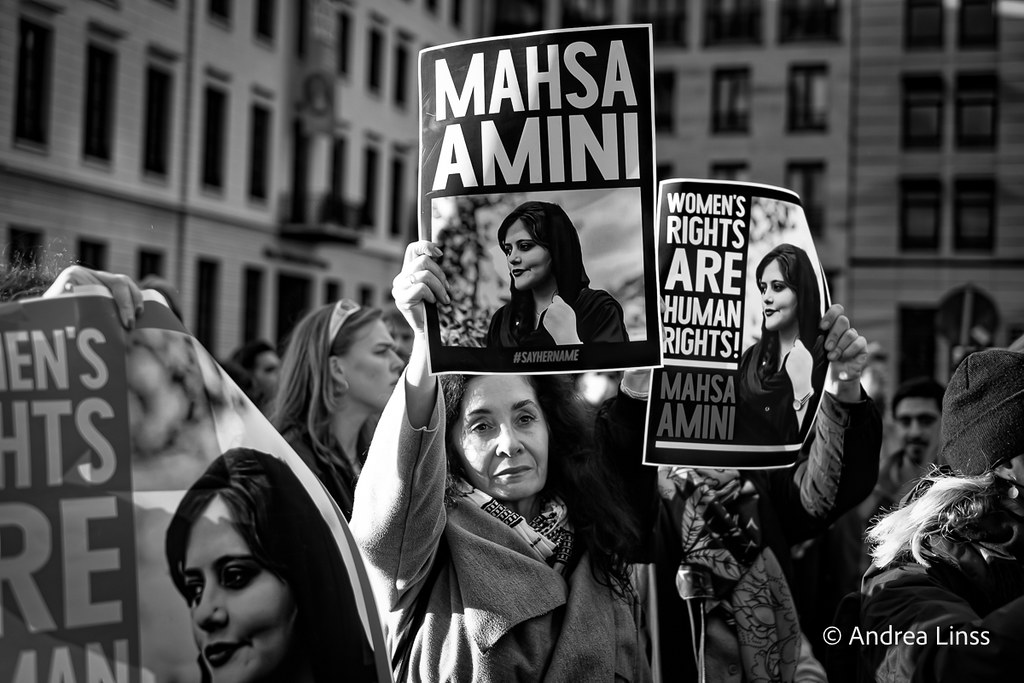September 16, 2022 – Mahsa Amini, a young Kurdish woman arrested in Tehran because her veil was poorly adjusted, was taken to the police station and did not come out alive. Immediately, news of the murder spread, and Iran was set ablaze. Hordes of women, with rage in their hearts, set fires, throwing their chadors into the flames. During the Fall, the Islamic Republic went through a major crisis of unprecedented proportions since its inception. One year after these events, the question arises regarding the state of the regime: to what extent has what is now commonly referred to as the “chador revolt” weakened the Iranian theocracy?
Revolt and reaction
A reminder of the chain of events: in the days and weeks following Mahsa Amini’s death, the clerics and the Revolutionary Guards trembled. While the latter cut off the internet, the protest spread to the inner circle of power: the Supreme Leader’s own sister embraced the cause of the protesters. Iranian women cut their hair, and the song “Barāyé” [“For” in Persian], which indicted the brutality of clerical dictatorship, became the anthem of a popular revolt that resonated across the world.
In October, the holiest symbols of the regime were targeted. Islamic television programs were hijacked, and Ayatollah Khamenei was accused of “spilling the blood of the youth.” A few days later, the statue of Imam Khomeini was toppled, and his birthplace was set on fire. In December, the revolt, seemingly unstoppable, reached a new level: the protests turned into incidents where the religious leaders had their turbans pulled off. Photos of this ultimate taboo being broken were circulated worldwide.
However, the mullahs and the Pasdars (Revolutionary Guards) quickly regained control. After being caught off guard, the authorities made numerous arrests. Leveraging many loyalists recruited abroad among Arabic-speaking Shiites, the Basij militia engaged in the bloodiest repression. Arrested protesters were crammed into the infamous Evin prison, subjected to arbitrary trials and torture sessions, with construction cranes doubling as gallows. Chilling images of hangings once again flashed across television screens.
The world moves on impassively
From as early as September, news of the tragedy spread beyond Iran’s borders. The tune of “Barāyé” was sung in unison by Western artists, while actresses and singers cut their hair in solidarity with their Iranian counterparts. In Paris, on January 16, as night fell, the slogan of freedom seekers – Zan, Zendegi, Azād [“Woman, Life, Freedom”] – lit up the first floor of the Eiffel Tower in illuminated letters. At the same time, Charlie Hebdo dedicated a special issue to Ayatollah Khamenei, depicting him as a cockroach giving birth to a bunch of little mullahs.
However, Westerners’ outrage over the Iranian tragedy proved to be ephemeral and superficial. While Iranian diasporas demonstrated in Paris, New York, Berlin, or London to condemn the repression, many feminists outside Iran adopted a wait-and-see approach, which was viewed as ambivalent by Iranian women. As Masih Alinejad, an Iranian journalist and women’s rights activist, wrote, “we have seen little evidence that women in Europe or North America are willing to take to the streets to show solidarity with the women’s revolution in Iran.”
Indeed, many American and European intellectuals were concerned that the bonfires of chadors might stigmatize women wearing niqabs and hijabs in the West. As Jean Birnbaum explained, on American and Western European campuses, many saw the “universalist feminism” embodied by Iranian women as a legacy of Euro-centric colonialism. According to those who gravitate in these circles, “the solidarity of Western women with their sisters in the land of Islam often masks a condescending, even racist attitude; activists who claim universalist feminism are blinded by their Western-centric blinders and thus become complicit in ‘white’ domination.”
When they did speak out, the international community’s outrage over the situation in Iran was therefore relative and explained mainly by the “grave mistake” committed by the mullahs in supporting Russia’s “special operation” in Ukraine. Just hours after the start of the Russian offensive, Iranian authorities implicitly legitimized Vladimir Putin’s decision by attributing the escalation of tensions in Eastern Europe to the United States and NATO. In the months that followed, as the conflict dragged on, Tehran further worsened its case by supplying Iranian-made drones to the number one public enemy. Invading the Ukrainian skies like mechanical locusts, the Shaeed-136 and Mohajer-6 drones even accompanied Vladimir Putin’s New Year’s wishes on January 1, 2023, with their lawnmower-like buzz.
Partisans and regime resilience
In Iran, despite the magnitude of the revolt, it quickly became apparent that the Islamic Republic could still rely on a core of unwavering supporters. The mullahs enjoyed the steadfast support of a fanatical proletariat estimated at a quarter of the population. Another notable fact is that most of the losses suffered by the armed forces of the Islamic Republic of Iran were recorded in the provinces of Sistan and Baluchestan and Kurdistan, as well as in Kurdish-populated cities in the western Azerbaijan and Kermānchāh provinces. This crisis that erupted in September 2022 was essentially a revolt that took place in the peripheral areas of the Islamic Republic.
Even in Tehran, the epicenter of the “chador revolt,” the movement had Kurdish roots. Its first victim, Mahsa Amini, whose Kurdish name “Gina” was prohibited in the capital, was buried in Saghez, her hometown and the home of the Peshmergas, while the slogan of the revolution, the famous “Zan, Zendegi, Azad,” was initially formulated in Kurdish before being translated into Persian.
With the support of its unwavering supporters and the relative indifference of the international community, the regime quickly regained its footing. Although it went through a major crisis, the Iranian theocracy could consider itself out of the woods at the beginning of 2023. While the “veil revolt” shook the regime and fueled hopes of its collapse among its opponents, it gradually suffocated under the regime’s henchmen. Content with releasing a few “sensitive” prisoners, emboldened and revitalized, they proudly celebrated the 44th anniversary of the Islamic revolution on February 11, 2023. During the summer, the morality police (Gasht-e Ershād) resumed its activities, and fines for Iranian women not wearing the headscarf were significantly increased. It is clear that the long-awaited political and ideological moderation of the Islamic regime is not on the horizon.
The rise of the guardians
Today, as the dust settles and the regime appears to have succeeded in containing the wave of protests that swept across Iran, a preliminary assessment can be made: it is horrifying, with over 500 protesters, including one-fifth children, killed by the authorities between September 16, 2022, and early 2023.
Notably, clashes with rioters also resulted in about a hundred deaths among Iranian security forces. Among them, 34 were Basij militia members, accounting for 52% of the total government casualties, while the Revolutionary Guards were relatively spared from the violence of the riots, with only 18% of government casualties. Having been at the forefront of crushing the revolt, the Guards are also the political winners of this crisis. During the crisis, they did not hesitate to distance themselves from the clergy, openly criticizing the excesses of the morality police and accusing it of igniting the spark that set off the powder keg.
If the four-decade-old regime is unreformable, and although the recent crisis has exposed its deep fracturation, its collapse is not imminent. Like after the popular protests of 1999, those following Ahmadinejad’s contested re-election in 2009, the aborted “Persian Spring” of 2011, and the wave of protests in 2018-2019, the Iranian regime is likely, once again, to demonstrate its extraordinary – and sinister – resilience. In addition to the life insurance provided by external support (Tehran has strengthened its ties with Moscow and Beijing), the regime has developed its own antibodies to face such challenges.
Far from undermining the regime, these crises that have followed one another since the beginning of the century have solidified the political base of what Iranians call the Sepāh-e Pasdaran. Denouncing the “color revolution” attempts attributed to Western powers, the Guardians have capitalized on their management of these rebellious movements to take the reins of anti-subversive reaction and, in the process, establish themselves as the true masters of Iran. Masters of counter-insurgency, they have turned Iran into a de facto military dictatorship. Like “communist” China and “democratic” Russia, behind this “theocratic facade” Iran is set to continue its institutional transformation to better integrate – and find refuge – within a new “illiberal” bloc that is taking shape around organizations such as the Shanghai Cooperation Organization and the BRICS, of which Tehran has recently become a member.
Conclusion
In Iran, if the columns of the Islamic Jericho trembled, the temple is not yet ready to collapse. The ruthless repression of the chadors’ revolt may have revealed the true face of the Mullahcracy to those who still had their eyes closed, but it remains firmly rooted in its original foundations, at least in the medium term. The Islamic Republic, pushed and sometimes staggering, has not changed one bit: it remains on the course set by its founding fathers in 1979. Neither encouragement, nor assistance, nor repeated crises have so far been enough to bend its radical trajectory or damage its dictatorial shell. On the contrary, whether motivated by naiveté or cynicism, Western chancelleries persist in making ill-advised decisions – such as Washington’s recent release of $6 billion – which, by replenishing the regime’s coffers, contribute to increasing its repressive capacity and prolonging its life expectancy. Iran remains one of the countries in the world where human rights (especially women’s rights) are the most violated, freedom of speech is the most controlled, and freedom of the press is the most suppressed. The long-awaited Persian Spring will have to wait.





Comments are closed.